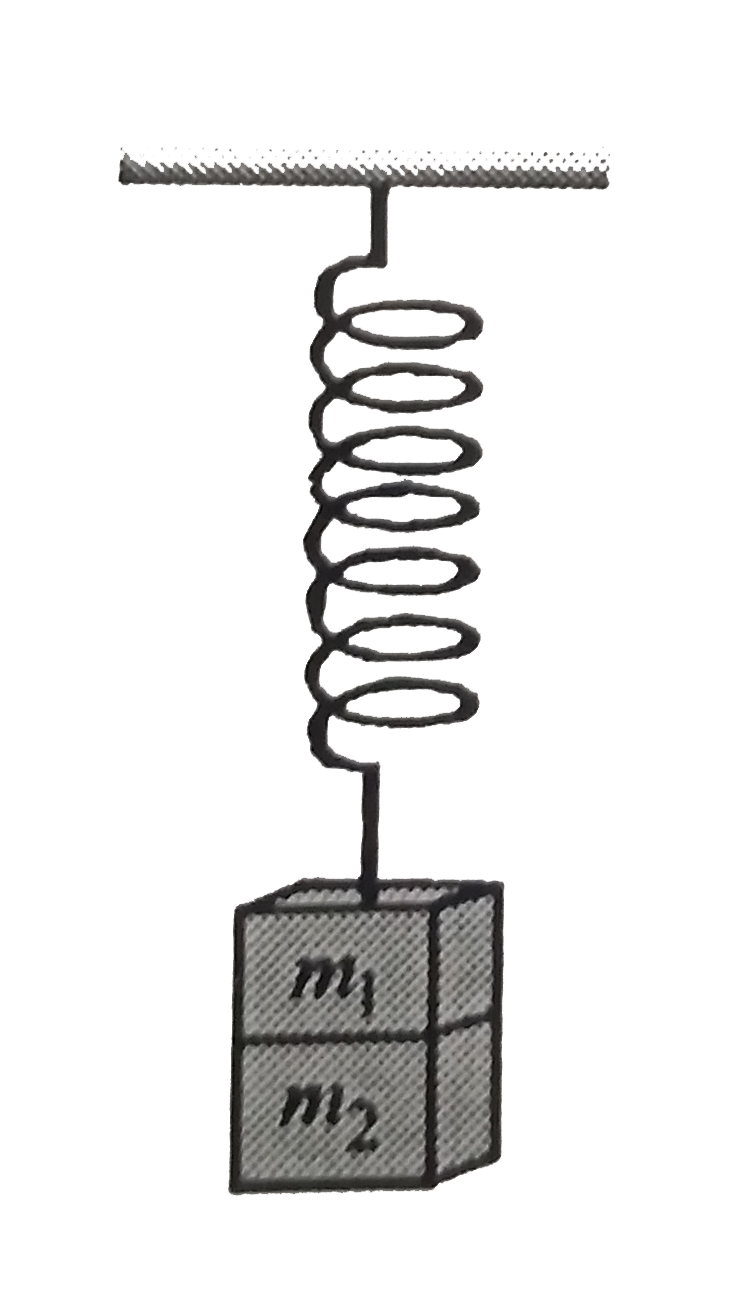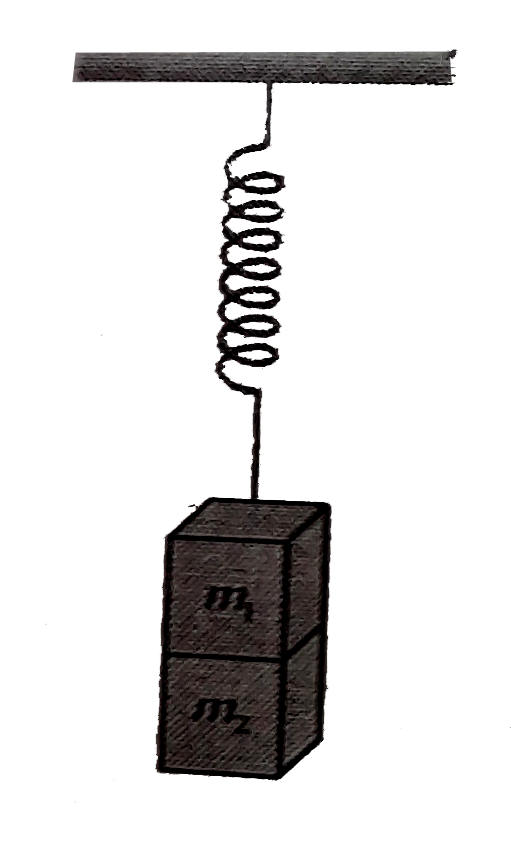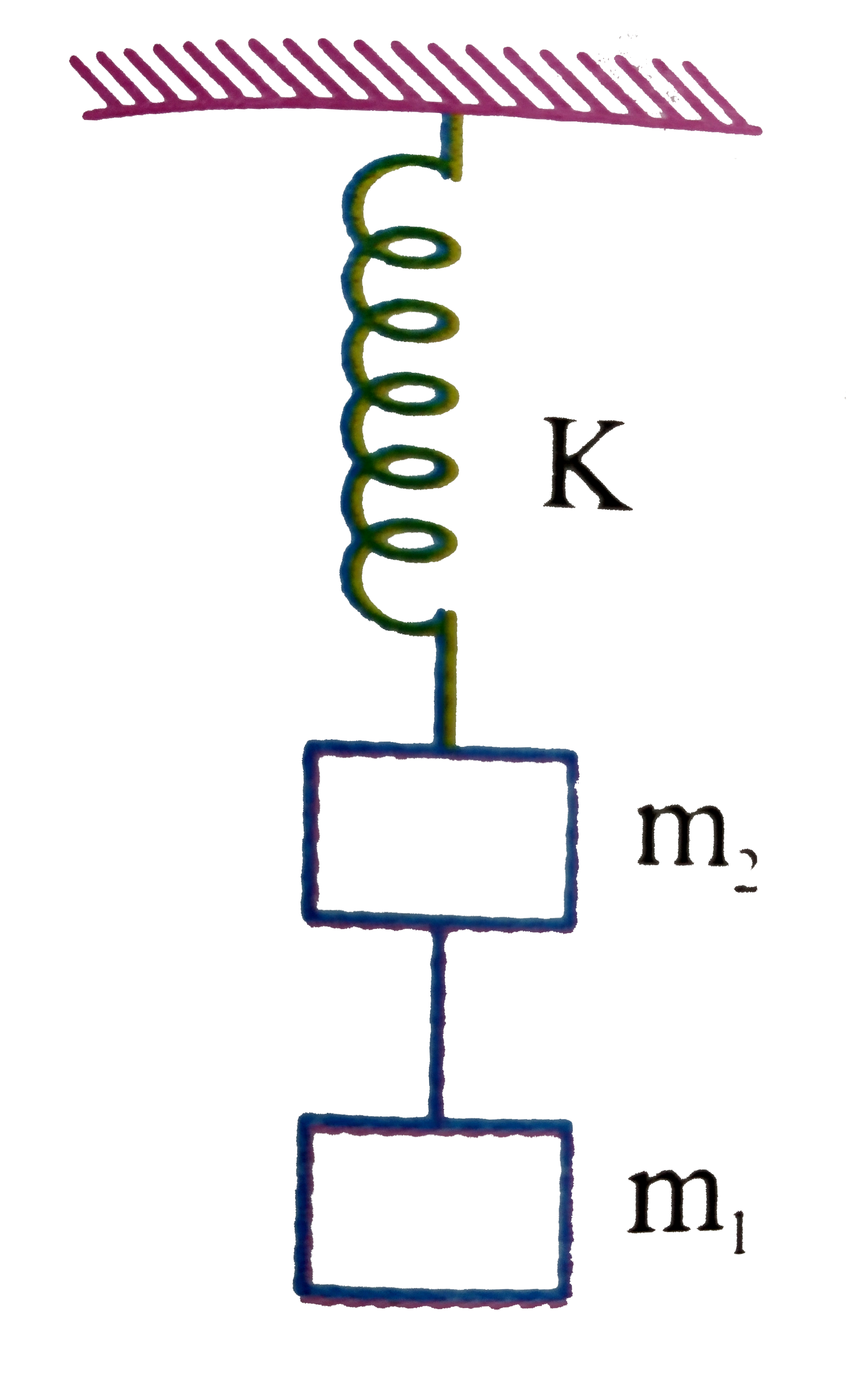Two masses m1=1kgandm2=0.5kg are suspended together by a massless spring of spring constant 12.5Nm−1. When masses are in equilibrium m1 is removed without disturbing the system. New amplitude of oscillation will be
30cm
50cm
80cm
60cm
The correct Answer is:C
To solve the problem step by step, we will analyze the situation when both masses are suspended and then when one mass is removed.
Step 1: Understand the initial equilibrium condition
When both masses m1 and m2 are suspended, they reach an equilibrium position where the gravitational force acting downwards is balanced by the spring force acting upwards. The total weight of the system is given by:
Fgravity=(m1+m2)g
where g is the acceleration due to gravity (approximately 10m/s2).
Step 2: Write the equation for the spring force
The spring force can be expressed as:
Fspring=kL
where k is the spring constant and L is the extension of the spring from its natural length.
Step 3: Set up the equilibrium equation
At equilibrium, the forces balance:
(m1+m2)g=kL
Substituting the values:
- m1=1kg
- m2=0.5kg
- k=12.5N/m
The equation becomes:
(1+0.5)⋅10=12.5L
15=12.5L
From this, we can find L:
L=1512.5=1.2m
Step 4: Analyze the situation after removing m1
Once m1 is removed, only m2 remains. The new equilibrium position will be determined by the weight of m2:
Fgravity=m2g=0.5⋅10=5N
Step 5: Write the new spring force equation
At the new equilibrium position, the spring force will now be:
Fspring=kL′
where L′ is the new extension of the spring.
Step 6: Set up the new equilibrium equation
At the new equilibrium, we have:
m2g=kL′
Substituting the values:
5=12.5L′
From this, we find L′:
L′=512.5=0.4m
Step 7: Calculate the change in extension
The change in extension ΔL (which will be the new amplitude of oscillation) is given by:
ΔL=L−L′=1.2−0.4=0.8m
Step 8: Convert to centimeters
To convert the amplitude from meters to centimeters:
ΔL=0.8m×100=80cm
Final Answer
The new amplitude of oscillation after removing m1 is:
ΔL=80cm
When both masses m1 and m2 are suspended, they reach an equilibrium position where the gravitational force acting downwards is balanced by the spring force acting upwards. The total weight of the system is given by:
Fgravity=(m1+m2)g
where g is the acceleration due to gravity (approximately 10m/s2).
The spring force can be expressed as:
Fspring=kL
where k is the spring constant and L is the extension of the spring from its natural length.
At equilibrium, the forces balance:
(m1+m2)g=kL
Substituting the values:
- m1=1kg
- m2=0.5kg
- k=12.5N/m
(1+0.5)⋅10=12.5L
15=12.5L
From this, we can find L:
L=1512.5=1.2m
Once m1 is removed, only m2 remains. The new equilibrium position will be determined by the weight of m2:
Fgravity=m2g=0.5⋅10=5N
At the new equilibrium position, the spring force will now be:
Fspring=kL′
where L′ is the new extension of the spring.
At the new equilibrium, we have:
m2g=kL′
Substituting the values:
5=12.5L′
From this, we find L′:
L′=512.5=0.4m
The change in extension ΔL (which will be the new amplitude of oscillation) is given by:
ΔL=L−L′=1.2−0.4=0.8m
To convert the amplitude from meters to centimeters:
ΔL=0.8m×100=80cm
The new amplitude of oscillation after removing m1 is:
ΔL=80cm
Topper's Solved these Questions
- BOOK - AAKASH INSTITUTECHAPTER - OSCILLATIONSEXERCISE - Assignment (Section - B) (OBJECTIVE TYPE QUESTIONS)30videos
OSCILLATIONS
- BOOK - AAKASH INSTITUTECHAPTER - OSCILLATIONSEXERCISE - Assignment (Section C) (PREVIOUS YEARS QUESTIONS)43videos
OSCILLATIONS
- BOOK - AAKASH INSTITUTECHAPTER - OSCILLATIONSEXERCISE - Exercise20videos
OSCILLATIONS
- BOOK - AAKASH INSTITUTECHAPTER - NUCLEIEXERCISE - ASSIGNMENT (SECTION-D)10videos
NUCLEI
- BOOK - AAKASH INSTITUTECHAPTER - PHYSICAL WORLDEXERCISE - ASSIGNMENT (Section-B)5videos
PHYSICAL WORLD
Similar Questions
Two masses m1 and m2 are suspended together by a massless spring of constant k. When the masses are in equilibrium, m1 is removed without disturbing the system. The amplitude of oscillations is
 View Solution
View SolutionTwo masses m1 and m2 are suspended together by a massless spring of constant K. When the masses are in equilibrium, m1 is removed without disturbing the system. Then the angular frequency of oscillation of m2 is -
 View Solution
View Solution
Knowledge Check
- Question 1 - Select One
Two masses 8 kg 4 kg are suspended together by a massless spring of spring constant 1000Nm−1 . When the masses are in equilibrium 8 kg is removed without disturbing the system. The amplitude of oscillation is
A0.5 mB0.08 mC0.4 mD0.04 m - Question 2 - Select One
Two masses m 1 and m 2 are suspended together by a massless spring of constant K . When the masses are in equilibrium, m 1 is removed without disturbing the system. The amplitude of oscillations is
 Am1gKBm2gKC(m1+m2)gKD(m1−m2)gK
Am1gKBm2gKC(m1+m2)gKD(m1−m2)gK - Question 3 - Select One
Two masses M and m are suspended together by massless spring of force constant -k. When the masses are in equilibrium, M is removed without disturbing the system. The amplitude of oscillations.
AMgkBmgkC(M+m)gkD(M−m)gk
Two mass m1 and m2 are suspended from a massless spring of force constant k. When the masses are in equilibrium, m1 is removed without disturbing the system. Find the angular frequency and amplitude of oscillations.
View SolutionTwo masses m1=1.0kgandm2=0.5kg are suspended together by a massless spring of force constant, k=12.5Nm−1. When they are in equillibrium position, m1 is gently removed. Calculate the angular frequency and the amplitude of oscillation of m2. Given g=10ms−2.
View SolutionTwo masses m1 and m2 are suspeded togther by a massless spring of spring constnat k (Fig). When the masses are in equilibrium, m1 is removed. Frequency and amplitude of oscillation of m2 are
 View Solution
View SolutionTwo masses m1 and m2 are suspended w together by a light spring of spring constant k as shown in figure. When the system is in equilibrium, the mass m1 is removed without disturbing the system. As a result of this removal, mass m2 performs simple harmonic motion. For this situation mark the correct statement(s).
 View Solution
View SolutionTwo masses m1and m2 are suspended from a spring of spring constant 'k'. When the masses are in equilibrium, m1 is gently removed. The angular frequency and amplitude of oscillation of m2 will be respectively
View Solution

